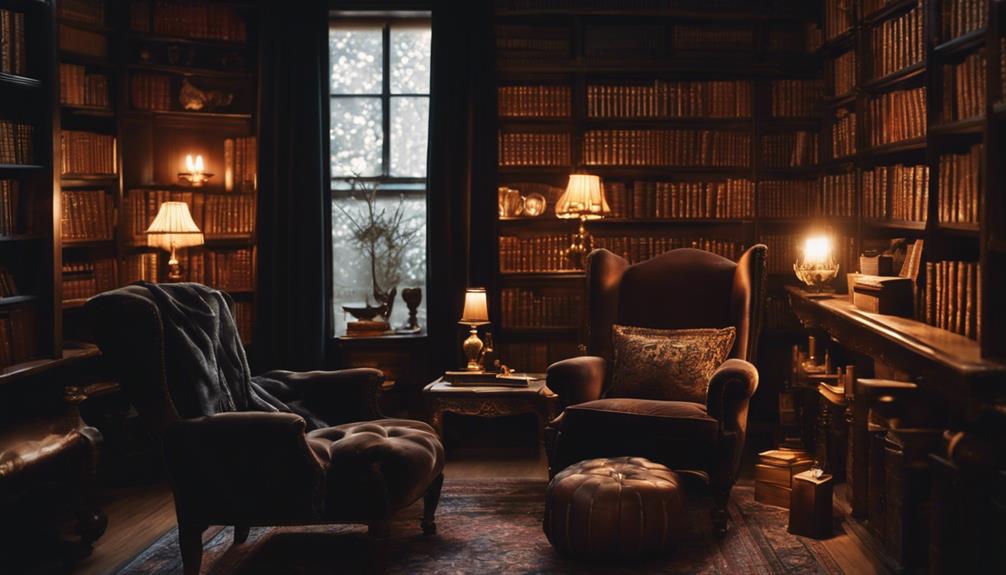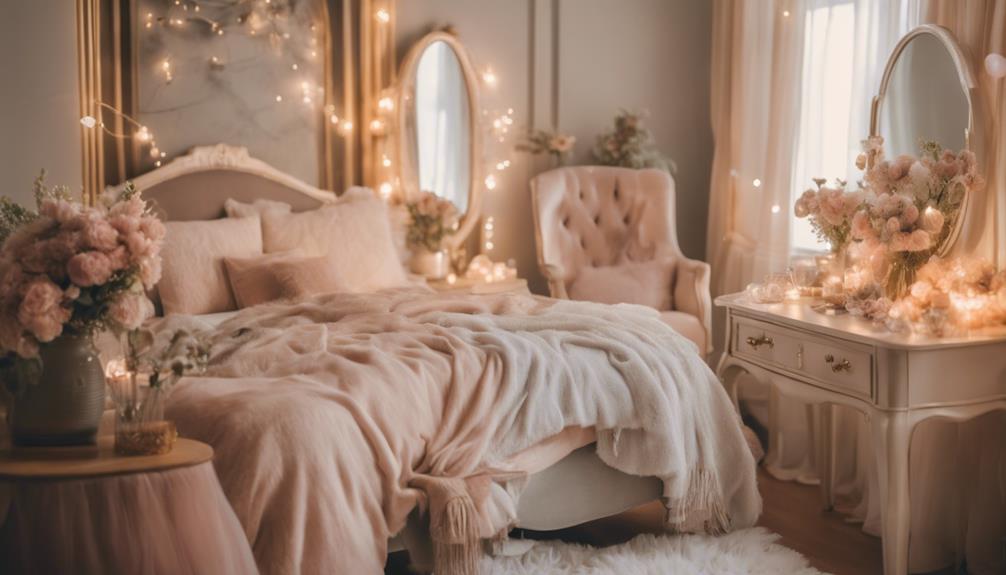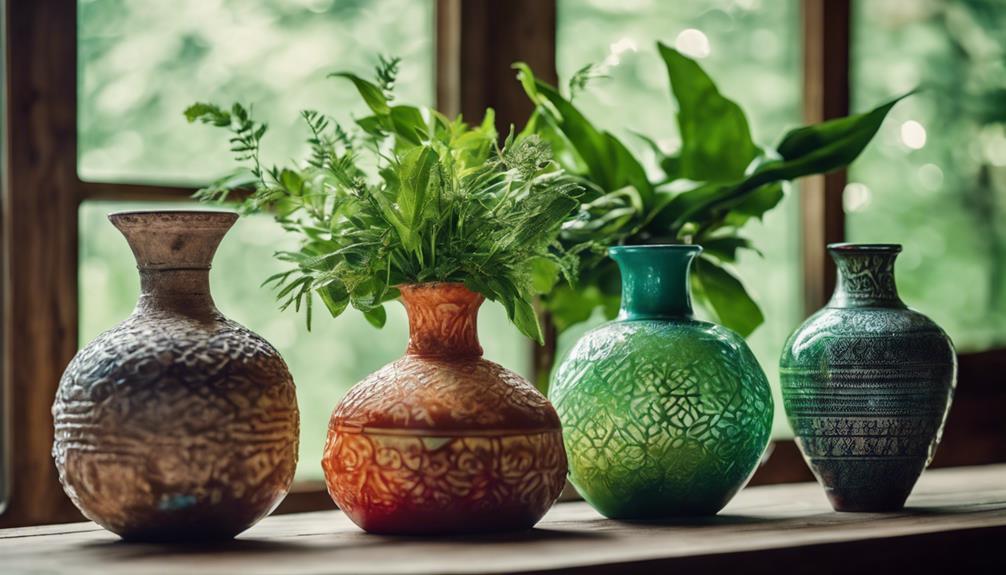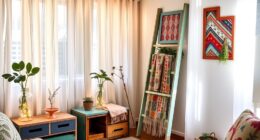You can dramatically transform your home with stunning late summer color schemes that capture the season's warmth and vibrancy. Think deep oranges and sunny yellows to evoke comfort, while cool blues can promote calmness. Use the 60/30/10 rule to balance your colors: 60% dominant, 30% secondary, and 10% accents. Consider integrating earthy hues, soft pastels, and dynamic combinations for visual interest. Don't forget about neutral tones to create cohesion. With a few simple swaps, like pillows or artwork, your space can feel fresh and inviting. There's even more inspiration awaiting you to enhance your home's seasonal charm!
Key Takeaways
- Use warm tones like deep oranges and sun-kissed yellows to evoke a cozy late summer atmosphere in your home.
- Incorporate soft pastels, such as peach and lavender, for light contrasts that brighten your space.
- Follow the 60/30/10 rule to maintain a balanced color distribution while creating visual interest.
- Refresh key decor elements, such as pillows and throws, to reflect seasonal changes and invigorate your home.
Choosing Your Color Palette

When choosing your color palette, let nature inspire you with its vibrant sunsets and soft floral tones to create a harmonious atmosphere in your home. Begin by considering the emotions different colors evoke. For example, blues often promote calmness, making them ideal for bedrooms, while yellows can infuse energy and cheerfulness into living spaces.
Before committing to a specific color, take a close look at your existing finishes. How will they interact with the new colors? Ensuring a cohesive look is essential for a well-designed room. Remember, color perception can shift dramatically with lighting. Evaluate how both natural and artificial light affect your chosen hues throughout the day.
To visualize how colors work together, use large samples of paint or fabric in your actual space. This practice helps you see how colors blend and interact, preventing any unpleasant surprises later. By taking the time to explore and test your color choices, you'll create a space that feels both inviting and reflective of your personal style.
Embrace the beauty of nature as your guide, and you'll find the perfect palette for your home transformation.
Understanding the 60/30/10 Rule
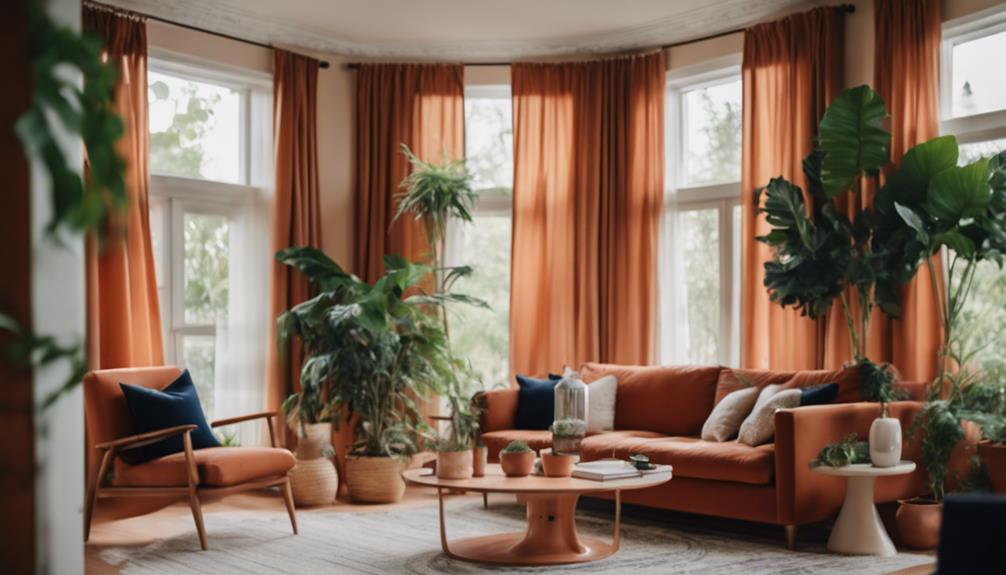
When you're planning your room's color scheme, the 60/30/10 rule can be your best friend.
This formula helps you select a dominant color for a cohesive backdrop, balance it with secondary tones for depth, and apply accent colors to add personality.
Let's explore how each component plays a crucial role in achieving a harmonious design.
Dominant Color Selection
The 60/30/10 rule simplifies color selection by guiding you to use one dominant color for 60% of your space, creating a strong foundation for your room's design.
Selecting the right dominant color is vital, as it sets the overall tone and mood for your area. Here are some tips to help you choose effectively:
- Consider Room Purpose: Think about how you want to feel in the space. For relaxation, opt for soft blues or greens; for energy, go for vibrant yellows or oranges.
- Test Large Swatches: Use large samples of your chosen dominant color on the walls or big furniture pieces. This helps you visualize how it interacts with natural light throughout the day.
- Think About Style: Align your dominant color with your personal style. A modern space might benefit from bold, dark colors, while a traditional room may shine with warm, muted tones.
- Balance with Texture: Incorporate different textures in your dominant color to add depth. For example, a cool gray can be enhanced with a plush sofa or a matte wall finish.
Balancing Secondary Tones
Balancing secondary tones is key to enhancing your room's design, ensuring the dominant color is complemented rather than overshadowed.
According to the 60/30/10 rule, your dominant color should cover about 60% of the room. This could be your wall color or large furniture pieces, setting the overall mood. Next, secondary colors should make up around 30% of the space. You can achieve this through draperies, accent walls, or smaller furniture, adding depth without overwhelming the primary hue.
Using variations of the same color family for your dominant and secondary tones helps create a harmonious look while keeping visual interest alive. For instance, if your dominant color is a deep blue, consider lighter shades of blue or complementary colors like soft grays or muted greens for your secondary tones.
Accent Color Application
Incorporating accent colors into your design not only adds personality but also completes the visual story of your space, following the 60/30/10 rule effectively. This balanced approach guarantees that your room feels cohesive and well-planned.
Here's how to apply the rule:
- Choose a Dominant Color (60%): Start by selecting a primary color that covers about 60% of your space. This could be your wall color or significant furniture pieces.
- Select a Secondary Color (30%): Pick a secondary color that complements your dominant hue, filling around 30% of the room with items like curtains or larger accent furniture.
- Add Accent Colors (10%): Finally, reserve 10% for your accent colors. These are the fun touches that bring character, usually found in smaller items like throw pillows, artwork, and decorative accessories.
- Consider Existing Elements: Before committing, evaluate the current colors and finishes in the room to guarantee a harmonious look.
Best Colors for Late Summer
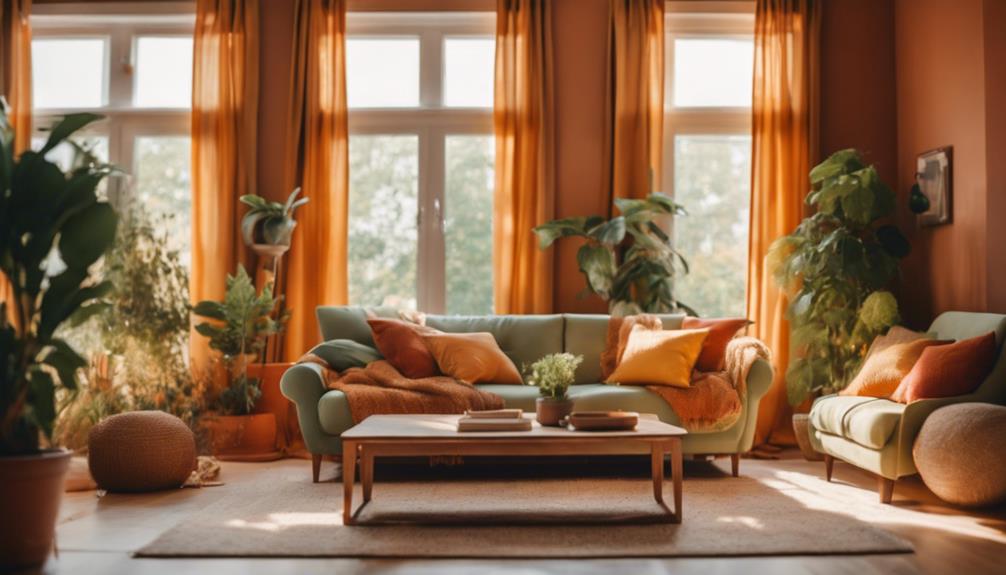
Warm tones like deep oranges and sun-kissed yellows capture the essence of late summer, infusing your space with comfort and vibrancy. To enhance this season's charm, consider blending earthy greens and browns, reminiscent of lush foliage and bountiful harvests. This combination creates a grounded aesthetic that adds depth to your decor.
You can also introduce soft pastels like peach, lavender, and mint to maintain a light and airy atmosphere. These hues provide a gentle contrast to the bolder colors in your summer color palette. By utilizing a mix of vibrant and muted tones, you'll achieve a dynamic yet cohesive look, effortlessly integrating seasonal decor with your existing elements.
Here's a quick reference table to help guide your late summer color choices:
| Color Type | Examples | Effect |
|---|---|---|
| Warm Tones | Deep Orange, Yellow | Comfort, Energy |
| Earthy Hues | Olive Green, Brown | Grounded, Natural |
| Soft Pastels | Peach, Lavender, Mint | Light, Airy |
Incorporating natural materials like wood and stone will further enhance this aesthetic, bringing the essence of late summer indoors.
Whole Home Color Considerations

Creating a cohesive whole home color scheme unifies your space, ensuring smooth passages between rooms and enhancing overall flow. To achieve this, consider the following tips:
- Stick to a Color Family: Choose variations within the same color family. This approach keeps your scheme harmonious while adding visual interest.
- Subtle Connections: Use matching accent colors or complementary shades in public areas. This helps avoid jarring contrasts and strengthens the cohesive whole home color scheme.
- Distinct Atmospheres: While common spaces benefit from a unified palette, allow for more diverse and personalized color choices in private areas, like bedrooms and studies. Tailoring color to each room's function can create unique atmospheres.
- Consistent Undertones: Pay attention to undertones across your chosen colors. Ensuring that they align can further enhance the flow and cohesion of your entire home.
Embracing Vibrant Summer Hues
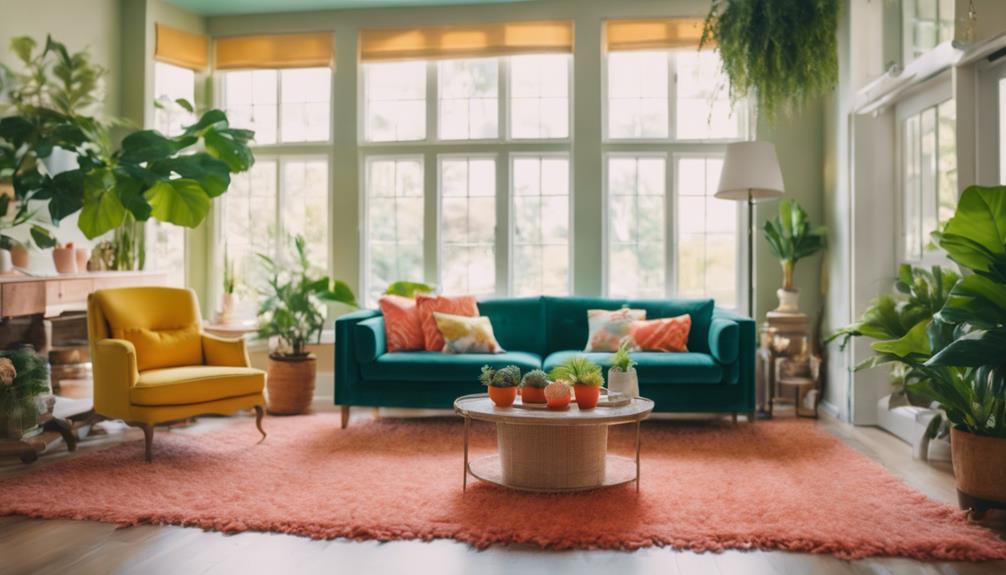
Summer invites you to embrace vibrant hues that can invigorate your space and reflect the season's lively spirit. By incorporating beachy blues and sunny yellows, you create a relaxed yet energetic atmosphere that enhances your home. To achieve balance, consider the 60/30/10 rule when selecting your colors.
| Color Allocation | Percentage |
|---|---|
| Dominant Shades | 60% |
| Complementary | 30% |
| Accent Colors | 10% |
Tropical palettes featuring deep greens and rich teals evoke warmth and a connection to nature, perfect for enhancing summer vibes. Don't shy away from experimenting with ice cream pastels; they add a soft, sweet touch that pairs beautifully with bolder colors. This playful combination allows you to create visual interest, making your space feel joyful and inviting.
Seasonal Decor Transformations
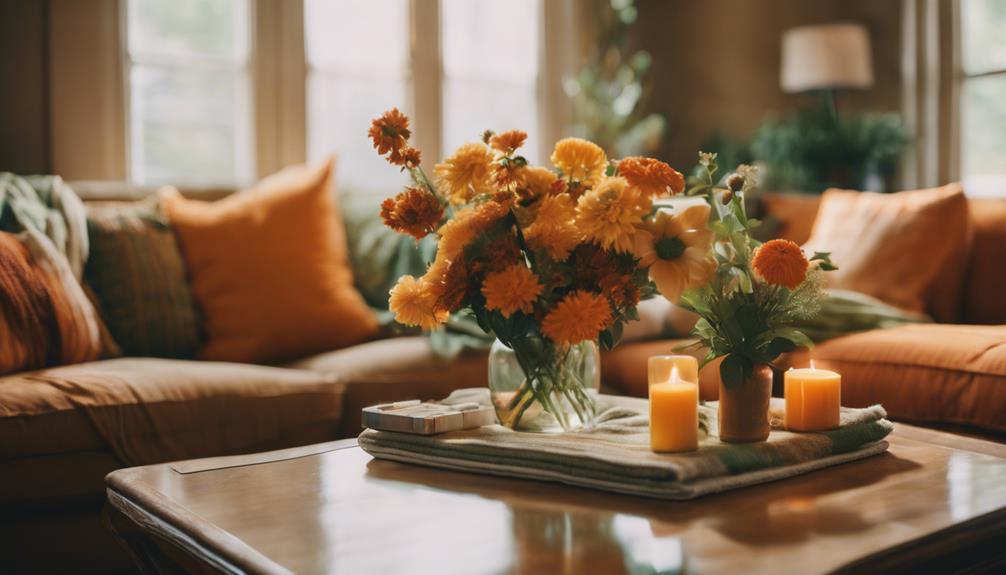
When it comes to seasonal decor transformations, you can easily refresh your space by swapping out key elements for vibrant colors inspired by the season.
Simple decor swaps, like changing throw pillows or adding seasonal accents, can dramatically shift the room's mood without extensive renovations.
Embracing versatile pieces allows you to create a cohesive look while effortlessly adapting your home to reflect the changing seasons.
Seasonal Color Inspiration
Transforming your decor with seasonal colors can breathe new life into your home, making it feel vibrant and inviting as late summer approaches.
As you reminisce about your summer vacation, reflect on how these colors can create a cozy atmosphere that captures the essence of the season.
Here are four color inspirations to reflect on:
- Deep Greens: Incorporate rich greens to evoke the lushness of late summer foliage, bringing a revitalizing vibe into your living space.
- Warm Yellows: Use bright yellows to energize your rooms, reminiscent of sunny days spent outdoors, creating a cheerful ambiance.
- Soft Pastels: Soft ice cream pastels can evoke nostalgia and warmth, perfect for a relaxed, cozy feel during the evenings.
- Citrus Shades: Add accents of lemon yellow and tangy orange to liven up your decor, making your home feel lively and inviting.
Easy Decor Swaps
Swapping out key decor elements can effortlessly refresh your space, reflecting the vibrant hues of late summer while keeping it inviting and lively. Start with easy decor swaps like changing your throw pillows and table runners to warm yellows, soft greens, and vibrant blues. These colors bring in the essence of the season and create a cheerful atmosphere.
Incorporate lightweight fabrics and summer-themed prints to enhance that breezy feel. Remember the 60/30/10 rule: use dominant colors for larger items like your sofa or curtains, while introducing secondary and accent colors through smaller items to maintain balance.
Don't forget to update your artwork or wall hangings. Coastal landscapes or botanical prints can instantly transform the room's vibe, making it feel fresh and seasonal.
Embrace versatile decor pieces, such as neutral bases, which you can easily enhance with colorful seasonal accessories. This approach allows for a smooth shift from summer to fall, ensuring your home always reflects the current season.
Integrating Neutral Tones
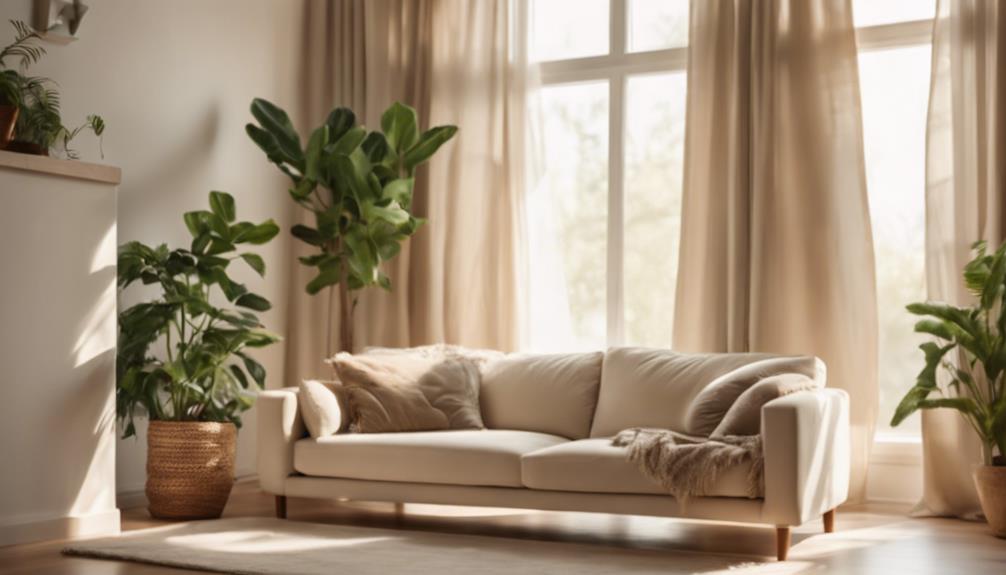
Integrating neutral tones into your home decor creates a versatile backdrop that effortlessly adapts to changing styles and seasons. By using shades like cream, beige, and gray, you establish a calming environment that promotes relaxation, especially in busy areas of your home. Neutral tones not only serve as a blank canvas but also allow for easy updates with vibrant accent colors.
Here are four ways to enhance your space with neutral tones:
- Layer Textures: Incorporate various materials such as soft throws, woven rugs, and textured cushions to add depth and visual interest without overwhelming the space.
- Add Patterns: Use patterned decor items like curtains or artwork in a neutral palette to keep the look dynamic yet cohesive.
- Accent Colors: Introduce seasonal accent colors through decorative items like pillows, art, and plants to refresh your decor effortlessly.
- Create Cohesion: Ascertain that furniture and fixtures complement your neutral tones, allowing for a harmonious flow throughout your home.
Community Inspiration and Ideas
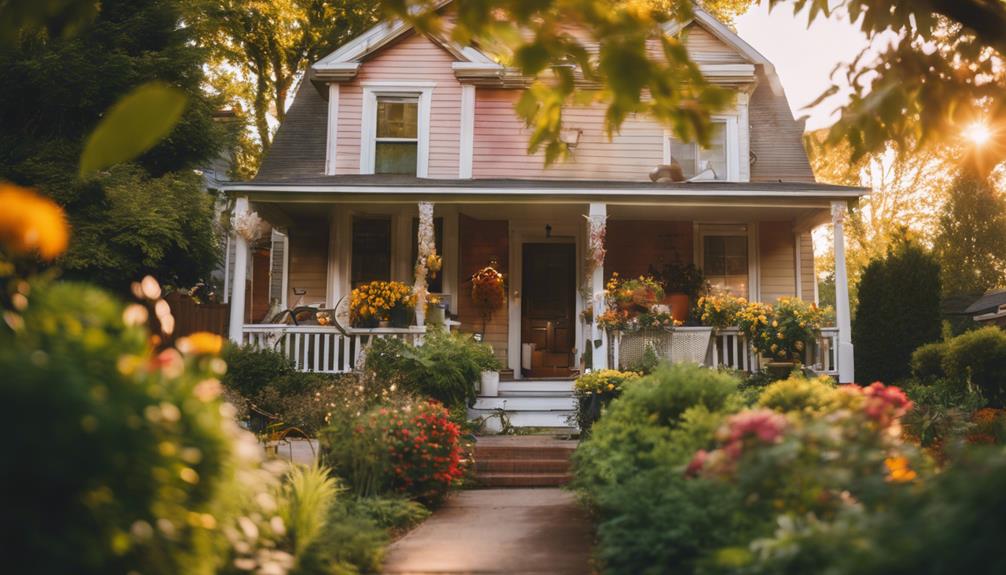
Sharing ideas and inspirations within your community can spark creativity and lead to exciting home decor transformations. Engaging with fellow decor enthusiasts through comments and social media can provide you with a wealth of community inspiration.
It's amazing how sharing a simple photo of your family room can ignite ideas for fresh new decor. You might find the right color to complement your summer hues or discover unique finds at local garage or antique sales that add character to your space.
Consider sprucing up your coffee table with green accents or last-minute updates that reflect the vibrant energy of late summer. Perhaps a small commission piece from a local artist can become the statement item your room needs.
Many bloggers share their transformations, showcasing how they've embraced seasonal color palettes that inspire you to experiment, too.
Don't hesitate to share your own decor journeys. Your experience can resonate with others and contribute to a collaborative atmosphere where everyone learns and grows.
Together, you can create stunning spaces that celebrate the beauty of community and the joy of home styling.
Shopping for Decorative Elements
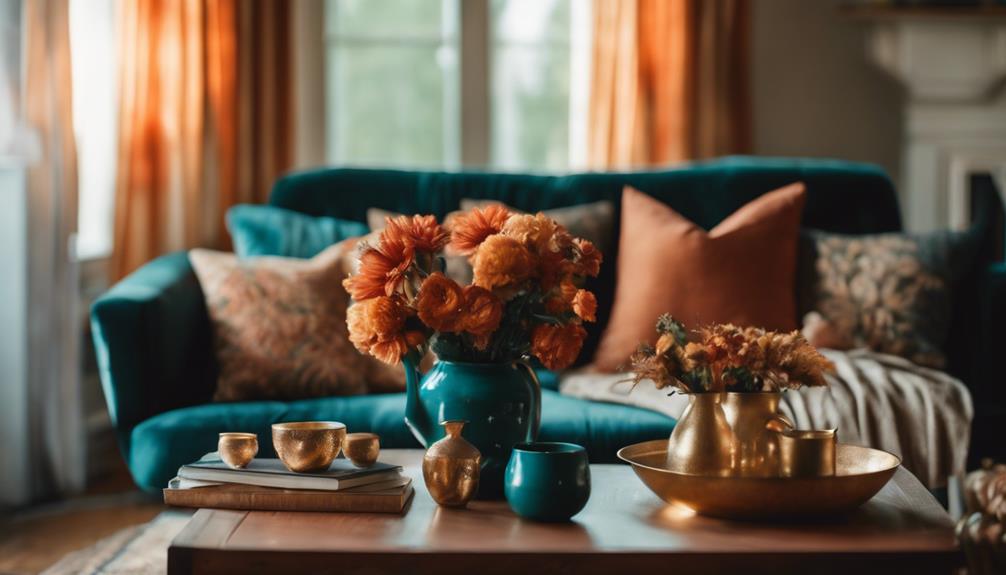
When you're shopping for decorative elements, knowing where to go can make all the difference.
Consider hitting stores like HomeGoods for seasonal decor trends and budget-friendly options that keep your space fresh.
You're bound to find unique pieces that fit your style without breaking the bank.
Ideal Store Locations
Finding the right store for decorative elements can elevate your home's aesthetic and keep your budget in check. As summer comes to an end, you'll want to find stores that offer unique pieces to enhance your late summer color schemes.
Here are four ideal store locations to take into account:
- HomeGoods: Known for its seasonal collections, HomeGoods provides unique and affordable decorative elements that reflect the latest design trends.
- Amazon: With an extensive selection of home decor items, Amazon allows you to make bulk purchases while checking customer reviews to verify quality.
- Local Antique and Garage Sales: These can be treasure troves for vintage decor pieces, offering one-of-a-kind finds at budget-friendly prices.
- Target and Walmart: These stores frequently update their home goods sections, making it easy to discover stylish accessories that won't break the bank.
Seasonal Decor Trends
Embracing seasonal decor trends can transform your space with vibrant colors and natural elements that reflect the beauty of late summer. To enhance your home's aesthetic, look for items in popular late summer color schemes like beachy blues, citrus yellows, and tropical greens. These hues can be easily integrated through throw pillows, decorative trays, and seasonal accents, adding life to any room.
Consider shopping at stores like HomeGoods and Amazon, where you'll find a variety of decorative items that align with these vibrant colors. Many shoppers prefer versatile decor pieces that shift seamlessly between seasons, such as lavender and green accessories. These colors not only bring a calming effect but also inject vibrancy into your summer spaces.
Don't overlook limited edition collections from brands like Tommy Bahama, which often feature trendy textiles perfect for seasonal updates. Additionally, exploring local antique and garage sales can uncover unique finds that complement your contemporary decor while adding a personal touch.
With these seasonal decor trends, you'll create a stunning late summer atmosphere that truly transforms your home.
Budget-Friendly Options
Shopping for budget-friendly decorative elements can be a rewarding experience, especially with so many options available at stores like HomeGoods and Amazon. You can easily find stylish pieces that fit your budget, allowing you to transform your space without breaking the bank.
To make the most of your shopping, consider these four items:
- Throws and Pillows: These can instantly refresh your living area and are often on sale, perfect for mixing summer and fall vibes.
- Decorative Trays: Versatile and functional, trays can organize items or serve as a stylish centerpiece.
- Faux Plants: They add a touch of greenery without the upkeep, and you'll find many options at budget-friendly prices.
- Seasonal Decor: Look for items that adapt well between seasons, like decorative accents that evoke the feeling of enjoying ice cream on a warm day.
Don't forget to explore thrift stores, garage sales, and clearance events. These can yield unique finds that add character to your home while keeping your budget intact.
With a little creativity, you can create a beautiful space that reflects your personal style!
Personalizing Your Space
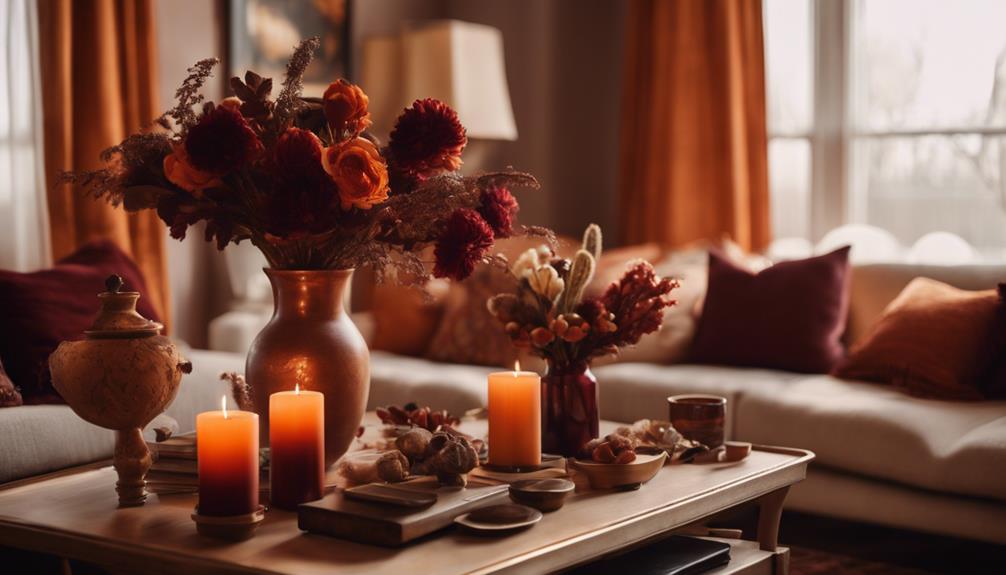
Personalizing your space means choosing colors that evoke your emotions and reflect your unique personality. If you're looking to create an environment that truly represents who you are, consider incorporating calming blues or energizing yellows. Using the 60/30/10 rule can help you achieve a balanced design—your dominant color sets the tone, while accent colors bring vibrancy.
To visualize how these colors will work together, try using large samples in your space. This guarantees they harmonize with your existing furnishings and lighting. Additionally, integrating sentimental decor items—like family heirlooms or personal artwork—adds a unique touch that makes your home feel inviting.
Here's a simple guide to help you choose:
| Color Category | Examples | Emotional Impact |
|---|---|---|
| Dominant Colors | Soft Blue, Warm Beige | Calm, Cozy |
| Accent Colors | Bright Yellow, Coral | Energetic, Happy |
| Sentimental Decor | Family Photos, Art Pieces | Nostalgic, Personal |
Explore color palettes inspired by nature, such as coastal blues or vibrant citrus shades, to create an atmosphere that aligns with your individual style. You won't believe the transformation!
Frequently Asked Questions
What Is the Best Color Scheme for Summer?
The best color scheme for summer features beachy blues, vibrant citrus, and tropical greens. These colors create a revitalizing atmosphere, while balancing ice cream pastels with deeper tones adds visual interest and a sweet vibe to your space.
What Summer Type Am I?
To determine your summer type, assess your skin's undertones and see which colors enhance your natural beauty. You might be Soft, Cool, or Warm Summer, each with unique shades that reflect your personality perfectly.
Am I Soft or Cool in Summer?
Are you soft or cool in summer? Look closely at your skin's undertones; soft summers glow in muted pastels, while cool summers shine in icy hues. Experiment with colors to discover which enhances your natural beauty best.
What Is the Difference Between True Summer and Soft Summer Colors?
True Summer colors feature cool, soft shades like lavender and teal, creating a calm vibe. Soft Summer colors incorporate earthy tones and muted neutrals, offering warmth and coziness. Choose based on the mood you want to evoke.
How Can Late Summer Color Schemes Transform My Home?
Transform your home with vibrant late summer home hues. Incorporate warm yellow, rusty orange, and deep green into your decor for an inviting and cozy atmosphere. These color schemes can breathe new life into any space, creating a relaxing and cheerful environment for you and your guests to enjoy.
Conclusion
With these stunning late summer color schemes, you can truly transform your home into a vibrant oasis.
By mixing bold hues with calming neutrals, you'll create a space that reflects your personality and style.
Remember, a fresh coat of paint can work wonders, so don't be afraid to think outside the box.
As the saying goes, “variety is the spice of life” – so embrace the colors of summer and let your creativity shine!



